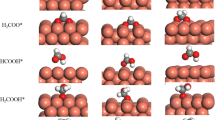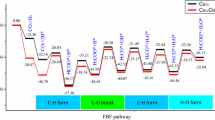Abstract
The conversion of CO2 to methanol (CH3OH) on Zr-doped Cu nanoparticle (NP) with icosahedral structure, is studied by density functional theory. The atom number of CuZr NPs is taken 13, 55 and 147, respectively and one Zr atom is doped at vertex (‘v’), edge (‘e’) or facet (‘f’) site on the CuZr NPs’ surfaces. The calculation results of the adsorption energies Eads of the concerned adsorbates, the activation energy Ea and the reaction energy (ΔE) at each reaction step, reflect the obvious influences of Zr doping site and the size of CuZr NPs on CO2 reduction activation. All the adsorption and reaction processes are found to perform around Zr atom, and except CO, the larger CuZr NP usually possesses the weaker adsorption for the adsorbates. On all the CuZr NPs, the rate determining step (RDS) occurs in the process of H3CO → CH3OH and the calculated Ea value at this step is found to be more closely related with Zr doping site. So, when Zr atom is doped at edge site on these CuZr NPs’ surfaces, the activation of CO2 is be well improved. Through comparing these CuZr NPs, Cu147Zre shows it’s better performance as the superior catalyst for CO2 reduction to CH3OH.
Graphical Abstract
The comparison of the energy barrier at the rate determining step (RDS) with a sequence in Ea values is Cu146Zre < Cu54Zre < Cu146Zrv < Cu54Zrv = Cu146Zrf < Cu12Zrv. The larger size of Cu nanoparticles or Zr doping at edge site on the surface of Cu nanoparticles will be in favor of enhancement in catalytic activation, and so Cu146Zre NP shows it’s superior catalytic properties in the reaction of CO2 conversion to CH3OH









Similar content being viewed by others
References
Knutson TR, Tuleya RE (2004) Impact of CO2-induced warming on simulated hurricane intensity and precipitation: sensitivity to the choice of climate model and convective parameterization. J Clim 17:3477–3495
Hansen J, Sato M, Ruedy R, Lo K, Lea DW, Medina-Elizade M (2006) Global temperature change. Proc Natl Acad Sci USA 103:14288–14293
Olah GA (2005) Beyond oil and gas: the methanol economy. Angew Chem Int Ed 44:2636–2639
Yang Y, Mims CA, Mei DH, Peden CHF, Campbell CT (2013) Mechanistic studies of methanol synthesis over Cu from CO/CO2/H2/H2O mixtures: the source of C in methanol and the role of water. J Catal 298:10–17
Jadhav SG, Vaidya PD, Bhanage BM, Joshi JB (2014) Catalytic carbon dioxide hydrogenation to methanol: a review of recent studies. Chem Eng Res Des 92:2557–2567
Beller M, Bolm C (2004) Transition metals for organic synthesis: building blocks and fine chemicals, 2nd edn. Wiley, Weinheim
Kuhl KP, Cave ER, Abram DN, Jaramillo TF (2012) New insights into the electrochemical reduction of carbon dioxide on metallic copper surfaces. Energy Environ Sci 5:7050–7059
Szanyi J, Goodman DW (1991) Methanol synthesis on a Cu(100) catalyst. Catal Lett 10:383–390
Yang YX, Evans J, Rodriguez JA, White MG, Liu P (2010) Fundamental studies of methanol synthesis from CO2 hydrogenation on Cu(111), Cu clusters, and Cu/ZnO(000). Phys Chem Chem Phys 12:9909–9917
Arakawa H, Dubois JL, Sayama K (1992) Selective conversion of CO2 to methanol by catalytic hydrogenation over promoted copper catalyst. Energy Convers Manag 33:521–528
Kopac D, Likozar B, Hus M (2019) Catalysis of material surface defects: multiscale modeling of methanol synthesis by CO2 reduction on copper. Appl Surf Sci 497:143783
Yoshihara J, Campbell CT (1996) Methanol synthesis and reverse water-gas shift kinetics over Cu(110) model catalysts: structural sensitivity. J Catal 161:776–782
Waugh KC (1992) Methanol synthesis. Catal Today 15:51–75
Liu X, Lu G, Yan Z, Beltramini J (2003) Recent advances in catalysts for methanol synthesis via hydrogenation of CO and CO2. Ind Eng Chem Res 42:6518–6530
Bansode A, Tidona B, von Rohr PR, Urakawa A (2013) Impact of K and Ba promoters on CO2 hydrogenation over Cu/Al2O3 catalysts at high pressure. Catal Sci Technol 3:767–778
Guo X, Mao D, Lu G, Wang S, Wu G (2011) The influence of La doping on the catalytic behavior of Cu/ZrO2 for methanol synthesis from CO2 hydrogenation. J Mol Catal A: Chem 345:60–68
Liu LN, Fan F, Jiang Z, Gao XF, Wei JJ, Fang T (2017) Mechanistic study of Pd-Cu bimetallic catalysts for methanol synthesis from CO2 hydrogenation. J Phys Chem C 121:26287–26299
Fujitani T, Nakamura I, Uchijima T, Nakamura J (1997) The kinetics and mechanism of methanol synthesis by hydrogenation of CO2 over a Zn-deposited Cu(111) surface. Surf Sci 383:285–298
Samson K, Śliwa M, Socha RP, Góra-Marek K, Mucha D, Rutkowska-Zbik D, Paul JF, Ruggiero-Mikołajczyk M, Grabowski R, Słoczyński J (2014) Influence of ZrO2 structure and copper electronic state on activity of Cu/ZrO2 catalysts in methanol synthesis from CO2. ACS Catal 4:3730–3741
Amenomiya Y (1987) Methanol synthesis from CO2 + H2 II. Copperbased binary and ternary catalysts. Appl Catal 30:57–68
Nitta Y, Fujimatsu T, Okamoto Y, Imanaka T (1993) Effect of starting salt on catalytic behaviour of Cu-ZrO2 catalysts in methanol synthesis from carbon dioxide. Catal Lett 17:157–165
Liu LN, Su XY, Zhang H, Gao NJ, Xue F, Ma YJ, Jiang Z, Fang T (2020) Zirconia-modified copper catalyst for CO2 conversion to methanol from DFT study. Appl Surf Sci 528:146900
Kattel S, Yan BH, Yang YX, Chen JGG, Liu P (2016) Optimizing binding energies of key intermediates for CO2 hydrogenation to methanol over oxide-supported copper. J Am Chem Soc 138:12440–12450
Li H, Shen YY, Du HN, Li J, Zhang HX, Xu CX (2021) Insight into the mechanisms of CO2 reduction to CHO over Zr-doped Cu nanoparticle. Chem Phys 540:111012
Austin N, Ye JY, Mpourmpakis G (2017) CO2 activation on Cu-based Zr-decorated nanoparticles. Catal Sci Technol 7:2245–2251
Zhang X, Liu JX, Zijlstra B, Filot IAW, Zhou ZY, Sun SG, Hensen EJM (2018) Optimum Cu nanoparticle catalysts for CO2 hydrogenation towards methanol. Nano Energy 43:200–209
Zhu W, Michalsky R, Metin O, Lv H, Guo S, Wright CJ, Sun X, Peterson AA, Sun S (2013) Monodisperse Au nanoparticles for selective electrocatalytic reduction of CO2 to CO. J Am Chem Soc 135:16833–16836
Delley B (1990) An all-electron numerical method for solving the local density functional for polyatomic molecules. J Chem Phys 92:508–517
Delley B (2000) From molecules to solids with the Dmol3 approach. J Chem Phys 113:7756–7764
Perdew JP, Burke K, Ernzerhof M (1996) Generalized gradient approximation made simple. Phys Rev Lett 77:3865–3868
Grimme S (2006) Semiempirical GGA-type density functional constructed with a long-range dispersion correction. J Comput Chem 27:1787–1799
Bergner A, Dolg M, Küchle W, Stoll H, Preuß H (1993) Ab Initio energy-adjusted pseudopotentials for elements of groups 13–17. Mol Phys 80:1431–1441
Delley B (2002) Hardness conserving semilocal pseudopotentials. Phys Rev B 66:155125
Halgren TA, Lipscomb WN (1977) The synchronous-transit method for determining reaction pathways and locating molecular transition states. Chem Phys Lett 49:225–232
Ou Z, Qin C, Niu J, Zhang L, Ran J (2019) A comprehensive DFT study of CO2 catalytic conversion by H2 over Pt-doped Ni catalysts. Int J Hydrogen Energy 44:819–834
Yang Y, White MG, Liu P (2012) Theoretical study of methanol synthesis from CO2 hydrogenation on metal-doped Cu(111) surfaces. J Phys Chem C 116:248–256
Huš M, Dasireddy VDBC, Štefančič NS, Likozar B (2017) Mechanism, kinetics and thermodynamics of carbon dioxide hydrogenation to methanol on Cu/ZnAl2O4 spinel-type heterogeneous catalysts. Appl Catal B: Environ 207:267–278
Lee JH, Kattel S, Jiang Z, Xie Z, Yao S, Tackett BM, Xu W, Marinkovic NS, Chen JG (2019) Tuning the activity and selectivity of electroreduction of CO2 to synthesis gas using bimetallic catalysts. Nat Commun 10:3724
Vasileff A, Xu C, Jiao Y, Zheng Y, Qiao S (2018) Surface and interface engineering in copper-based bimetallic materials for selective CO2 electroreduction. Chem 4:1–23
Author information
Authors and Affiliations
Corresponding author
Additional information
Publisher's Note
Springer Nature remains neutral with regard to jurisdictional claims in published maps and institutional affiliations.
Supplementary Information
Below is the link to the electronic supplementary material.
Rights and permissions
About this article
Cite this article
Li, H., Luan, X.S. & Shen, Y.Y. The Size and Doping Site Consideration in Methanol Synthesis on CuZr Nanoparticles. Catal Lett 153, 1036–1045 (2023). https://doi.org/10.1007/s10562-022-04041-z
Received:
Accepted:
Published:
Issue Date:
DOI: https://doi.org/10.1007/s10562-022-04041-z




